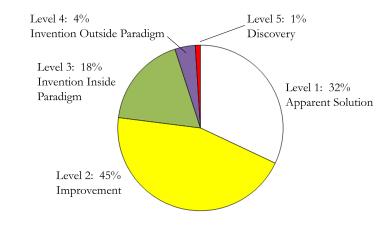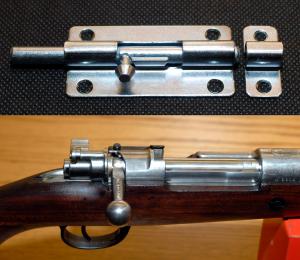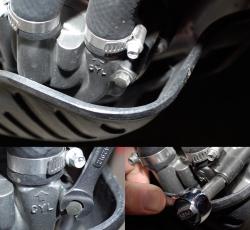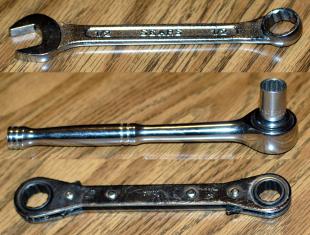TRIZ: How to Stimulate Engineering Creativity Using TRIZ
TRIZ is an acronym for teoriza rezhinija izobretatalskih zadach, or the theory of inventive problem solving. The TRIZ technique was developed by Genrich Altshuller, a Russian navy officer who worked in the Soviet patent office. After reviewing 40,000 patents, Altshuller reached the following conclusions:
- Inventions and innovations follow common patterns that cut across industry and technology boundaries.
- Innovation is a process that can be taught.
- Inventions fall into levels ranging from adapting existing concepts (a common practice) to completely new discoveries (a relatively rare practice).
Altshuller’s formalization of the TRIZ process was hugely successful in the Soviet Union, and TRIZ has been widely studied by western cultures. The technique figures prominently in Six Sigma and other product and process improvement technologies.
Levels of Invention
Altshuller categorized inventions into five levels:
- Level 1: Apparent Solution. This level requires no real invention; it consists of minor adaptations of existing concepts. Altshuller found that fully 32 percent of all patent applications were in this category.
- Level 2: Improvement. This level makes small improvements to existing approaches. Altshuller found about 45 percent of all patent applications fell into this category.
- Level 3: Invention Inside the Paradigm. This level uses methods from other fields and improves previous approaches. About 18% of all patent applications were in this category.
- Level 4. Invention Outside the Paradigm. This level involves a new design that is based on modifications of existing principles but in a manner not previously used. These are relatively rare; Altshuller found that only 4% of patent applications were in this category.
- Level 5: Discovery. This is the highest invention level. It consists of completely new concepts using new principles. Less than 1% of all the patent applications were in this category.
We can use Altshuller’s findings as a tool to guide us in creating new inventions.
Figure 1. Altshuller’s Levels of Invention. Very few patent applications represented truly new concepts; most were modifications or adaptations of earlier ideas.
Perhaps one of the best examples of the above concept predates Altshuller’s observations about very little being new in the world of inventions. Paul Mauser’s invention of the bolt action rifle in the late 1800s was inspired by the bolt on a simple gate latch. Figure 2 makes this very obvious.
Figure 2. Bolt Mechanisms On Gate Latch and Mauser Rifle. A simple gate lock mechanism inspired the bolt action rifle.
Using TRIZ
Altshuller’s theory of inventive problem solving is simple. It recognizes that all design challenges contain contradictions. The contradictions are grouped into two categories:
- Technical Contradictions. Technical contradictions involve compromises between competing parameters. If we want to increase strength, we have to also increase weight. If we want to increase capacity, we have to increase size. An improvement in one parameter involves degradation in another.
- Physical Contradictions. Physical contradictions involve time or space, where a product must do different things depending on the condition or the time in which it must perform its functions. We might have a condition where two objects need to occupy the same space, or a product needs to perform different functions under different conditions.
Resolving Physical Contradictions
The solution to such physical contradictions typically involves separation in time or space (and sometimes by condition). Figure 3 shows contradictions resolved in time and space.
Figure 3. Chicago’s Elevated Railway Over Street Intersection. This solution resolves physical contradictions through separation in space (the elevated railway) and time (the traffic lights).
The common two-part epoxy is a demonstration of contradiction resolved by condition. The epoxy must be soft to allow mixing and application, but hard to join parts together. Epoxy is kept in liquid form so that it can flow and be mixed. After mixing, it solidifies and forms a powerful bond and seal. Aircraft controls have a contradiction based on a requirement for multiple functions versus light weight. This contradiction is also resolved by condition (aircraft switchgear performs multiple functions depending on aircraft condition).
Resolving Technical Contradictions
The approach for resolving technical contradictions involves use of Altshuller’s problem solving principles along with another tool he developed: The contradiction matrix. The contradiction matrix is an elegant approach for resolving technical contradictions.
To resolve technical contradictions, we first have to recognize and describe the contradiction. Unlike most design approaches in which resolving the contradiction usually involves compromises, TRIZ resolves conflicts without compromising. We can do this by considering the resources or properties available to us that are inherent to the system, and by using the contradiction matrix.
The contradiction matrix is a 39 x 39 matrix. The matrix rows list parameters we want to change, and the columns are conflicting parameters. The rows and columns list the same items; we just need to find pairings that are in conflict by identifying one parameter in a row and the other in a column (or vice versa). At the intersection of the rows and columns (the cells inside the 39 x 39 matrix), the matrix suggests which of Altshuller’s 40 inventive principles might help resolve the conflict.
The above sounds simple, and after you’ve used it a bit, it is. There’s a learning curve, though, and it takes some practice to become adept at using the technique (there’s some art in identifying the inherent conflict and deciding which of the 39 row and column descriptors best fit the conflict).
Figure 4. Limited Access Bolt Head. The head is accessible with a box end wrench, but not with a ratchet, making it slow to remove. We would like to have a tool that fits into the limited access area and provides rapid removal.
Let’s consider an example. Suppose we have a situation with a relatively inaccessible bolt head as shown in Figure 4, and we need to shorten the amount of time it takes to remove the bolt. There are two approaches to consider. We can use a standard wrench (but it is slow), or we could use a ratchet and socket (it’s faster, but the ratchet won’t fit). This is our conflict. The questions we face in applying TRIZ to this situation are:
- What categories in the contradiction rows and columns are applicable?
- At the intersection of the conflicting requirements, which inventive principles are applicable?
For a complete listing of the TRIZ contradiction matrix, take a look at http://www.triz40.com/aff_Matrix.htm (the matrix is too big to appear in full here). In our example, we’ll opt for Parameter 4 along the top (length of stationary object) and Parameter 25 along the right (loss of time). Parameter 25 is very closely aligned with our situation, but Parameter 4 is just a bit of a stretch (it’s the closest one related to size, so that’s why we selected it).
If we read down the Parameter 4 column until it intersects with the Parameter 25 row (see Figure 5, excerpted from the contradiction matrix), we see four inventive principles (merging, curvature increase, intermediary, and flexible shells and thin film).
| Worsening Feature | ||
| 4. Length of Stationary Object | ||
| Improving Feature | 25. Loss of Time | 30 24 14 5 |
Figure 5. Contradiction Matrix Excerpt. The contradiction matrix suggests examining four inventive principles for the wrench problem.
Not all of the inventive principles listed in the intersection will offer solutions, and there is some art in applying the contradiction matrix. Experience in using the technique helps, and the best way to gain this experience is to start using the approach. (The Eogogics Unleashing Engineering Creativity Workshop can help you accelerate your learning curve for TRIZ as well as many other powerful creativity enhancement techniques.) In this application, it is difficult to envision how using a curvature increase, an intermediary component or subassembly, or flexible shells and a thin film solve the problem. But what about Inventive Principle 5, or merging? Might that offer a potential solution?
Figure 6. Box End, Ratchet, and Ratcheting Box End Wrenches. The ratcheting box end wrench is the result of applying Inventive Principle 5, or merging.
If we ponder this for a bit, merging does indeed offer a potential solution. If we merge the concepts inherent in a standard wrench and a ratchet and socket, we have the ratcheting box end wrench (see Figure 6). The application works well, as Figure 7 shows.
Figure 7. Ratcheting Box End Wrench. This tool provides rapid removal and installation with limited bolt head access.
Summary and Suggested Activity
Very few innovations are truly new concepts. We can take advantage of this when faced with creativity challenges by using TRIZ techniques. TRIZ recognizes that all inventive problems involve either technical or physical contradictions. Physical contradictions can usually be addressed via separation either in time or in space. Technical contradictions can usually be addressed through the use of the contradiction matrix. Once we’ve identified the contradictions, the contradiction matrix will suggest which of the 40 inventive principles offers potential solutions.
Here’s a suggested activity: Suppose you wish to develop a printer capable of printing a standard 8½ x 11 page, and the printer can be no larger than a smart phone. What are the contradictions inherent to this creative challenge? What does the contradiction matrix suggest as potential inventive principles to consider in meeting this creative challenge?
Editor’s Note: This article summarizes the TRIZ chapter of the Eogogics book Unleashing Engineering Creativity by Joe Berk, a Principal Member of the Eogogics Engineering Faculty. The book is the textbook component of the Eogogics Unleashing Engineering Creativity Workshop, available worldwide as a customized, client-site class. The book can be bought separately from Eogogics but is also included free with the Workshop. For details of the workshop or the book, please visit www.eogogics.com/creativity. You can read the book’s full chapter on TRIZ there as well. For more on the workshop, email us or call us at +1 703 281 3525 (in the USA, 1 888 364-6442).


Sorry, comments for this entry are closed at this time.